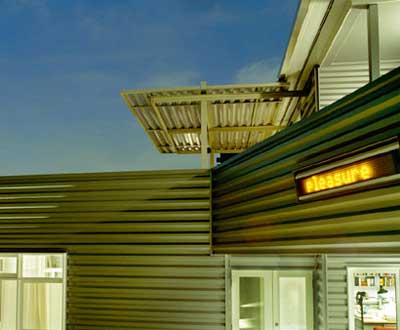 Gregg Segal: Joe Day House, Silver Lake #1, 2004 Epson Archival digital print on aluminum, 30"x40" Picturing the Modern World: The Photography of "Dwell" Peter Brown, Mark Gilbert, Misha Gravenor, Daniel Hennessy, Todd Hido, Dave Lauridsen, Catherine Ledner, Miranda Lichtenstein, Gregg Segal, Mark Steinmetz, Zubin Shroff, Hertha Hurnaus, Peter Marlow, Stephen Oxenbury, Paco Perez James Nicholson Gallery is pleased to present an exhibition of architectural photography to mark the fourth anniversary of "Dwell" magazine. The artists in this exhibition have all been featured in the pages of "Dwell" and represent the magazine's distinctive vision. Launched in 2000, "Dwell" has created a unique approach to architectural photography, recognizing that a space takes form from its designer, while a home gains meaning from its inhabitants. It is this essential interdependence that the artists in "Picturing the Modern World" make visible. With these images, the search for the perfectly styled, perfectly isolated, perfectly anesthetized house is replaced with an examination of the human presence, whether in the form of a figure or its trace, that makes a particular space remarkable. The history of architectural photography speaks of the evolution of architecture since the invention of the camera. In the United States, the post World War II promise of an era of hope and innovation found its embodiment in modernist architecture. Consumer magazines seeking to popularize the new architecture crafted highly seductive images of a world available to those within its modern walls. Often these images included the careful insertion of a flawless model posed to exemplify the myriad functions that one's modern home could support. A half-century later, "Dwell" extols the virtues of a new kind of modernist architecture for which they have coined the term "nice modernism." Nice modernism is filled with just as much hope and promise as its post-war precursor, but aspires to a humanism, an accessibility that its forbearer could not truly fulfill. More than just a style, it is a way of living, whose best quality, according to "Dwell", is its flexibility, a feature that one does not usually ascribe to modernism. In the same way that post-war modernist architecture fashioned its own style of photography, "Dwell"'s nice modernism necessitates its own approach to capturing the built world. Ever determined to refute the long held notion that modern architecture is uncomfortable and impossible to live with, "Dwell" replaces the starched Julius Shulman models with real people in the most personal of places, their homes. The photographs become not just a document of architectural fact but a recording of place, space, and contemporary culture. In doing so, they have succeeded in crafting a new narrative style of architectural photography that seemingly owes more to 1970s New Topographic photographers such as Lewis Baltz and Robert Adams than to the great icons of architectural photography such as Shulman and Ezra Stoller. Although varying greatly in subject and style, the photographs featured in "Picturing the Modern World" succeed in just this-giving the viewer a picture of a world filled with modern. We see a world in which a sleek L.A. home shares a wall with a junkyard and an ironing board gets a glimpse of the picturesque from its place in front of a large expanse of glass bedroom wall. A world in which the perfection of built-in cabinetry is normalized by the messiness of an unmade bed and the reality of pop culture is made visible by the flickering of "South Park" on the television screen. Somewhere between a peek into the most intimate corners of someone's home and a bird's eye view of an architectural feat in its entirety, we gain a better understanding of the built world through the people whose lives are shaped by these spaces. "Dwell" has been integral in documenting the proliferation of nice modernist design throughout the United States and abroad. In doing so, they have made it accessible and, in turn, desired. It could be said that "Dwell", and the photographs in this exhibition, have had a hand in promulgating the democratization of style that has become the new ideal for the consumer culture of the 21st century, one that, although more attainable than ever before, is still coveted by many. Exhibition: October 13 - November 13, 2004 Gallery Hours: Tue-Fri 11am - 5:30pm, Sat 11am - 5pm James Nicholson Gallery 49 Geary Street, 4th Floor USA-San Francisco, CA 94108 Telephone +1 415 397 0100 Fax +1 415 397 0155 Email: info@nicholsongallery.com www.nicholsongallery.com |